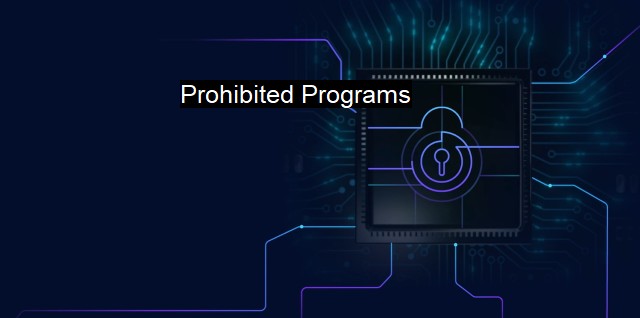What are Prohibited Programs?
Prohibited Programs in Cybersecurity: The Critical Need to Identify and Restrict the Use of Malware, Hacking Tools, and More
Prohibited programs in the context of cybersecurity are those applications that are deemed harmful due to their structure or intent that may threaten an individual, network, or a system’s security. These are pieces of software that can penetrate a user's computer system without explicit consent and potentially pose serious hazards to the integrity and confidentiality of data stored.The issue of prohibited programs is alarming because these software packages are either designed or could be repurposed to launch cyber-attacks by exploiting security flaws, pilfering data, damaging files, and incorporating computer systems into botnets. They generally circulate through freeware, spam emails, unsafe downloads, or unsecure network connections.
Malware is a prominent example of such prohibited programs, and it comes in various forms. Viruses are malicious applications that can replicate and infect other programs, meanwhile, Worms can clone themselves and spread through a network without any user's intervention. Trojans, aptly named after the renowned Greek metaphor, camouflages as a normal, harmless program, and when downloaded, it creates a backdoor that can allow cybercriminals to have discretionary access to victims' computer systems.
Ransomware, another form of malicious software, locks down files on the victim’s computer and demands a ransom to get them back. Then there’s Spyware, which is programmed to steal information about an individual's or a group's internet usage, personal details, and sensitive data, sharing it with a third-party entity without the users' consent. Rootkits are software packages that can grant to the infiltrator elevated access to a computer without being detected.
Adware is a less publicized but equally problematic prohibited program. Although not usually harmful in the traditional sense, adware has the potential to jeopardize privacy by observing user behavior online and displaying intrusive advertisements.
Apart from these, there are prohibited programs designed for a particular harm, like keyloggers, which keep track of every keystroke on the keyboard to collect private data, such as credit card numbers, passwords and others. Instead of implementing these purposes overtly, hackers may use prohibited programs to initiate Distributed Denial of Service (DDoS) attacks in which multiple systems are used to clog a network or flood a server with excessive traffic, making online services unavailable to users.
It's also important to note Grayware, an umbrella term for software that exhibits domineering or reckless behaviors. Grayware isn't explicitly malicious but can diminish system performance and, in turn, lower productivity while potentially breaching one’s privacy.
To protect against these security threats, anti-virus software is essential. These programs keep an updated virus definition database, scan all files, and, if anything is commonly found with malware, they inhibit its activity, delete the offending file or place it in a 'virus vault'. Most antiviruses use heuristic analysis for threat detection. They use algorithms to scrutinize files and identify patterns hazardous to a computer system.
Firewalls are equally critical in addition to an antivirus. They trace and block traffic, both incoming and outgoing, founded on an established list of security rules and prevent any unauthorized access to or from the network.
Users also play an important role in cybersecurity. By practicing 'good hygiene'- avowing suspicious emails, verifying downloads, keeping their operating system and applications up to date – users can drastically decrease the chance of accidentally incorporating prohibited programs into their systems.
To encapsulate, prohibited programs jeopardize not only the confidentiality of our data but also the integrity and availability of our systems. Thus, understanding them and taking the necessary actions against them is essential to maintain the cybersecurity landscape.

Prohibited Programs FAQs
What are prohibited programs in the context of cybersecurity?
Prohibited programs in the context of cybersecurity are software or applications that are considered harmful or pose a security threat to computer systems or networks. These programs can be used for malicious purposes such as stealing personal data, spying, or spreading malware.What are some examples of prohibited programs?
Some examples of prohibited programs include malware, spyware, keyloggers, rootkits, remote access tools, hacking tools, and any other software that can be used to gain unauthorized access or control over a computer or network.Why are prohibited programs a concern for antivirus software?
Prohibited programs are a concern for antivirus software because they can evade detection and compromise the security of computer systems or networks. Antivirus software is designed to detect and remove malicious programs, but prohibited programs can be designed to avoid detection by antivirus software, making them a serious threat to cybersecurity.How can I protect my computer from prohibited programs?
You can protect your computer from prohibited programs by using antivirus software that is regularly updated to detect and block the latest threats. It is also important to avoid downloading software from untrusted sources and to be cautious when opening emails or attachments from unknown senders. Keeping your operating system and software updated with the latest security patches can also help to prevent prohibited programs from exploiting vulnerabilities in your system.| | A | | | B | | | C | | | D | | | E | | | F | | | G | | | H | | | I | | | J | | | K | | | L | | | M | |
| | N | | | O | | | P | | | Q | | | R | | | S | | | T | | | U | | | V | | | W | | | X | | | Y | | | Z | |
| | 1 | | | 2 | | | 3 | | | 4 | | | 7 | | | 8 | | |||||||